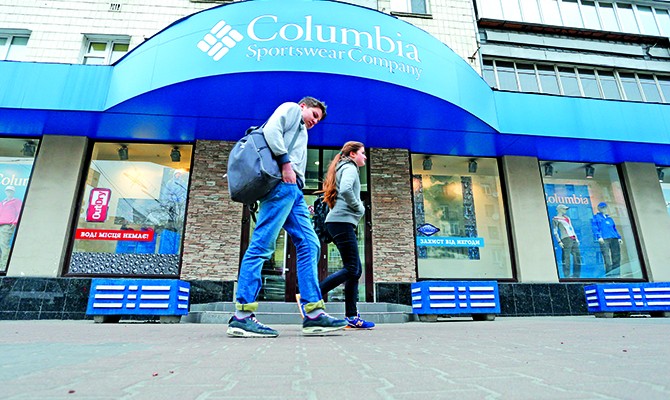Economy
optiizationClothing and footwear chains are shutting down unprofitable outlets in Ukraine

Retailers are losing customers. Over the first five months of the year, the sales in volume terms halved compared with the same period of 2013, General Director of Ultra group of companies (Baldinini, Levi’s, Pierre Cardin, Lagerfeld and Guess chains) Andriy Makarov told Capital. “The outlets operating in the upper-medium segment suffered most,” he explains. Development Director of Luxoptica Yevhen Malev says sales of glasses and sunglasses in Sunochki chain dropped 30% in January-June 2014 compared with the same period last year.
The sales dropped, among other reasons, because of increased prices. The chains purchase the items they offer abroad, which is why devaluation of the national currency affected the prices of goods, explains Makarov. Also the purchasing power is on the decline as the majority of Ukrainians tighten their purses. “The average receipt in Luxoptica chain decreased 10-15% to UAH 300-350,” adds Malev. That is why the turnover of the majority of retailers shrunk in dollar equivalent.
Military conflict in Donbas forced Ukrainians postpone their shopping for clothes and footwear. From mid-May until now the stores in the east of the country sold five times fewer goods compared with the same period of last year, General Director of Kari Ukraine (Kari chain) Maksym Mazitov told Capital. “Around 20% of our outlets are located in the east of the country,” he said, adding that the sales were declining also in other regions of the country.
For retailers the decreasing sales came as a total surprise: many of them were planning to expand their chains. For instance, Kari Ukraine earlier planned to open around 70 outlets by the end of 2014. “These plans have naturally been suspended,” he says. The market players are focusing on sustaining their existing businesses.
Imperative of our time
Retailers have tried to reduce operating expenses by reducing the expenses for the space lease. There has been a wave of additional contracts to the lease agreements between retailers and owners of shopping malls on the market. The players demanded to tie the lease rates to a preferential exchange rate of UAH 8-9.5/US $1 and also provide up to 30-40% additional discounts to the initial price. “We have agreed with the shopping centers on a compromise as to the lease of space for 80% of our outlets,” admitted Andriy Makarov. If the owners of shopping malls refused to make concessions, the retailers simply closed their outlets without any hesitation. “We failed to agree on the lease conditions that would be acceptable for us,” a representative of Lee Cooper clothing chain, who asked not to be named, told Capital.
All negotiations with retailers are held individually and the company always tried to reach compromise, said Yulia Schatlivaya, chief of lease department at Arricano development company. “It is very difficult to find a replacement for a tenant,” she adds. Discounts, however, are provided for a very short period, three months on average, which is why the shopping malls are continuously in the process of negotiations.
Fighting for profits
Reduction of leasing rates does not always hold retailers back from shutting down outlets or chains. Some retailers are concentrating on their main businesses, which bring profits. For instance, Intermoda-Trade (In Wear/Matinique, Naf-Naf, Minelli, Marela, Laurel, Claire’s, Inter-moda Trade chains) was forced to shut down the Minelli chain of footwear stores (around 10 outlets), Luxoptica is closing Sunochki chain (6 stores). Other retailers, such as Helen Marlen Group, are closing outlets to focus on the development of online stores.
Sometimes, retail chains make compromise decisions. Instead of reducing the number of outlets, they reduce the leased space. Ultra, for instance, reduced the space of its Lagerfeld store at Sky Mall from 200 sq m to 100 sq m, and Guess – from 240 sq m to 150 sq m.
Mass sales
The newly adopted measures did not save market players from forced early sales. Last year, seasonal sales started in July, while this year they began in May. Many retailers offered up to 30-50% discounts for new collections. “It is practically impossible to sell goods without discounts,” the co-owner of Zeebra (Butlers, Six, I am, Glossip chains) Dmytro Yermolenko told Capital. Now, these chains are ready to sacrifice their markup in order not to be left with overfilled warehouses at the end of the season. This summer is the last season of mass sales and there will be a wide selection of goods at discount prices. In the fall retailers will reduce their selection of goods. “We reduced our selection by half,” admits Makarov. Mazitov adds that Kari will also reduce the availability of new collections.






 of the agreement of syndication with Financial Times Limited are strictly prohibited. Use of materials which refers to France-Presse, Reuters, Interfax-Ukraine, Ukrainian News, UNIAN agencies is strictly prohibited. Materials marked
of the agreement of syndication with Financial Times Limited are strictly prohibited. Use of materials which refers to France-Presse, Reuters, Interfax-Ukraine, Ukrainian News, UNIAN agencies is strictly prohibited. Materials marked  are published as advertisements.
are published as advertisements.